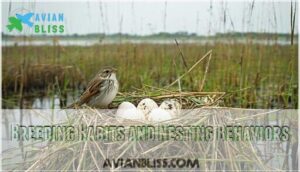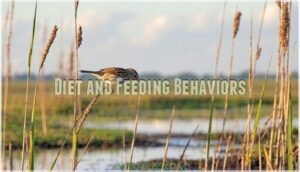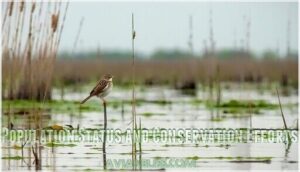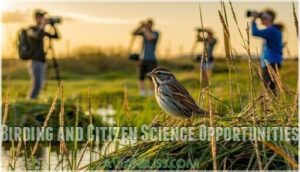This site is supported by our readers. We may earn a commission, at no cost to you, if you purchase through links.
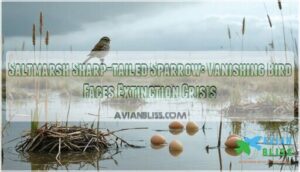 You’ll find the saltmarsh sharp-tailed sparrow teetering on the edge of extinction in Northeast salt marshes.
You’ll find the saltmarsh sharp-tailed sparrow teetering on the edge of extinction in Northeast salt marshes.
This small, secretive bird has lost over 75% of its population since 1990, with scientists predicting complete extinction within 30-50 years.
Rising sea levels flood their ground-level nests faster than they can rebuild, making this species nature’s alarm bell for coastal climate change.
The saltmarsh sharp-tailed sparrow lives exclusively in tidal marshes from Maine to Virginia, where it breeds in summer and faces an uphill battle against drowning habitat.
Understanding this bird’s unique adaptations and urgent conservation needs reveals why saving salt marshes matters more than ever.
Table Of Contents
- Key Takeaways
- Saltmarsh Sharp-tailed Sparrow Overview
- Physical Characteristics and Identification
- Habitat and Range
- Breeding Habits and Nesting Behaviors
- Diet and Feeding Behaviors
- Migration Patterns and Timing
- Population Status and Conservation Efforts
- Threats and Predators
- Research and Scientific Studies
- Birding and Citizen Science Opportunities
- Frequently Asked Questions (FAQs)
- What is the difference between a Nelson’s sparrow and a saltmarsh sparrow?
- Are saltmarsh sparrows endangered?
- What eats saltmarsh sparrows?
- What is the difference between a seaside sparrow and a saltmarsh sparrow?
- What is a sharp tailed sparrow?
- Are Saltmarsh sparrows a single species?
- What does a saltmarsh sparrow look like?
- Could Saltmarsh sparrows be extinction?
- How hard is it to get a saltmarsh sparrow?
- Should saltmarsh sparrow be listed under the Endangered Species Act?
- Conclusion
Key Takeaways
- You’ll witness one of North America’s most endangered species facing extinction – the saltmarsh sharp-tailed sparrow has lost 87% of its population since 1998, with scientists predicting complete extinction within 25-30 years without immediate conservation action.
- Rising sea levels are drowning their future – these specialized coastal birds nest exclusively in high marsh areas that flood with increasing frequency, causing 60-80% nest failure rates as climate change accelerates habitat loss.
- You can spot them by their distinctive orange facial stripes and spiky-tipped tails – these medium-sized sparrows live only in Atlantic coast salt marshes from Maine to Virginia, making them one of North America’s most habitat-specialized birds.
- You can help save them through citizen science and habitat protection – participate in marsh monitoring programs, support wetland conservation efforts, and advocate for climate action to protect the remaining 30,000-60,000 individuals left in the wild.
Saltmarsh Sharp-tailed Sparrow Overview
You’ll find the saltmarsh sparrow clinging to life in the narrow strip where land meets sea.
These endangered songbirds face extinction as rising seas devour their coastal marsh sanctuary.
This endangered species has mastered evolutionary adaptations for survival in coastal salt marshes from Maine to Virginia.
These coastal birds depend entirely on high marsh areas where saltmeadow cordgrass grows above regular tidal reach.
Climate change impacts now threaten their very existence.
Rising seas flood nests with increasing frequency, while mercury bioaccumulation poses new dangers.
The sparrow’s specialized nesting strategies once worked perfectly in stable marshes, but today’s rapidly changing conditions outpace their ability to adapt.
Habitat restoration efforts focus on creating elevated nesting sites and controlling water levels during breeding season.
These marsh birds represent nature’s incredible specialization—and its vulnerability when human activities disrupt delicate coastal ecosystems.
Similar to the swamp sparrow’s habitat, these birds require specific wetland environments.
Physical Characteristics and Identification
You’ll recognize this vanishing bird by its distinctive features that set it apart from other sparrows.
The saltmarsh sparrow displays a robust body with a remarkably short tail featuring spiky-tipped feathers.
Its moderately long, conical bill helps distinguish it from similar species.
The bird’s striking facial pattern includes gray cheeks adorned with bright orange stripes, creating bold facial markings that catch your eye.
This sparrow identification relies heavily on plumage variations showing orange-buff, leaden gray, and rusty brown coloration.
To improve your birding skills, consider using quality glass binoculars for brighter images.
Key identification features include:
- Size Comparison: Medium-sized sparrow, larger than Common Yellowthroat but smaller than Song Sparrow
- Tail Morphology: Short tail with distinctively spiky feather tips
- Bill Shape: Moderately long and conical for seed consumption
- Facial Markings: Bold orange stripes contrasting with gray cheeks
Males and females share identical plumage, making this monomorphic species easier to identify once you know these sharp-tailed sparrow characteristics.
Habitat and Range
The saltmarsh sharp-tailed sparrow calls one of North America’s most specialized environments home. These birds occupy tidal salt marshes exclusively along the Atlantic coast from Maine to Virginia, with winter ranges extending south to Florida.
Salt marsh ecology creates perfect conditions where freshwater meets saltwater in coastal saltmarshes. You’ll find these Atlantic coast birds in high marsh areas dominated by saltmeadow cordgrass and saltmarsh rush.
These coastal wetlands flood less frequently than lower areas, providing safer nesting spots. The birds prefer supratidal zones – elevated areas above regular tidal reach. Tidal influence shapes everything about their world.
The twice-daily tide cycles affect food availability and nesting success. Unfortunately, habitat loss from rising sea levels threatens their survival. To mitigate this, creating artificial nesting sites can provide vital refuge.
Key habitat features include:
- Marsh vegetation like cordgrass and saltgrass
- Elevated nesting areas above high tide lines
- Dense plant cover for protection
- Proximity to tidal creeks for foraging
Range expansion remains limited due to their specialized needs. Without suitable coastal wetlands, these birds can’t establish new populations elsewhere.
Breeding Habits and Nesting Behaviors
Against the backdrop of rising tides and shrinking marshes, saltmarsh sparrows face their greatest challenge during breeding season. These resilient birds construct cup-shaped nests from grasses and sedges, carefully positioning them in high marsh areas dominated by saltmeadow cordgrass.
The nesting location proves critical as females lay 3-5 speckled eggs in late spring through summer. Nest construction occurs just above the high tide line, where nest elevation becomes a delicate balance between safety and accessibility.
Parents share duties, with males defending territories while females handle most parental care responsibilities. However, nest flooding during storm surges and extreme high tides leads to devastating nest failure rates. To attract mates, males engage in elaborate courtship rituals.
Key breeding challenges include:
- Clutch size averaging 4 eggs per attempt
- Nest flooding causing 60-80% reproductive losses
- Limited suitable high marsh habitat for bird nesting
- Breeding success declining as sea levels rise
This precarious reproductive cycle highlights why immediate conservation action remains essential for species survival.
Diet and Feeding Behaviors
Understanding this saltmarsh sparrow’s diet means exploring how these birds adapt to their challenging coastal world.
Their prey items include insects, seeds, and small crustaceans found throughout salt marshes.
These bird species have developed specific diet adaptations to handle high salt intake from their saltmarsh habitat.
The sparrow’s foraging strategies involve gleaning insects from vegetation surfaces and probing soft mud for hidden invertebrates.
Their bird behavior shows remarkable timing – they feed during low tides when mudflats expose more food sources.
This bird diet changes seasonally as different prey becomes available.
Their feeding ecology demonstrates how saltmarsh sparrows balance nutritional needs with salt tolerance.
They must process excess salt through specialized glands while maintaining energy for survival.
Some birds exhibit unique water-based feeding techniques to acquire food.
- Foraging tactics include:
- Gleaning from vegetation
- Probing in mud
- Edge-of-water feeding
Migration Patterns and Timing
These secretive sparrows undertake remarkable journeys between their breeding and wintering grounds.
Saltmarsh sparrow migration patterns reveal birds traveling from Northeast U.S. breeding areas to wintering grounds spanning Delaware through Florida.
Migration triggers include changing day length and food availability, while climate impacts increasingly affect their traditional routes.
Spring migration timing depends on environmental cues that signal favorable breeding conditions.
Their migratory connectivity links specific breeding populations to distinct wintering areas, creating vulnerability when habitats disappear.
Stopover ecology plays a vital role as birds rest and refuel during these arduous journeys.
Birds use visual landmarks like coastlines for guidance.
To better understand these patterns, the following steps can be taken:
- Track bird migration timing through citizen science programs
- Monitor tidal marsh stopover sites for resting sparrows
- Document how climate change affects migration patterns
- Record bird migration behaviors alongside other marsh species
Understanding these patterns helps scientists predict how rising seas will impact future movements and survival rates.
Population Status and Conservation Efforts
You’re witnessing one of North America’s most endangered bird species facing extinction. The saltmarsh sparrow has experienced a devastating population decline of 87% since 1998, with current numbers estimated at fewer than 70,000 individuals.
This decline causes alarm among scientists who project extinction within 25-30 years without immediate action.
Bird conservation efforts are ramping up across the Atlantic Coast through coordinated programs. The Atlantic Coast Joint Venture leads these conservation efforts, bringing together federal agencies, states, and nonprofits.
Their bird habitat restoration work includes:
- Restoring natural tidal flow in degraded marshes
- Adding dredged sediments to increase marsh elevation
- Removing invasive plants like Phragmites
- Installing water control structures
- Creating conservation easements to protect breeding areas
Future projections remain grim despite these mitigation strategies. Protecting critical habitats is essential for these species, as seen in efforts like Protecting critical habitats. Research gaps exist in understanding how quickly these birds can adapt to rising seas, limiting conservation impact.
Threats and Predators
The saltmarsh sparrow faces a perfect storm of threats that’s pushing this species toward extinction.
While conservation efforts continue, multiple dangers work against these vulnerable birds.
Sea-Level Rise represents the most pressing threat.
Rising waters flood nests during high tides, drowning chicks and destroying eggs.
Climate Change Impacts intensify storm surges that devastate breeding colonies.
Habitat Loss from coastal development shrinks available nesting areas by over 50% since the 1800s.
Three major predator groups target saltmarsh sparrows:
- Mammalian predators – Raccoons destroy up to 65% of nests, while red foxes and feral cats hunt adults and young
- Avian predators – Northern harriers and marsh wrens prey on eggs and nestlings
- Reptilian predators – Snakes access nests in fragmented marsh edges
Invasive Species like Phragmites degrade nesting habitat quality.
Mercury Bioaccumulation presents emerging health risks.
Nest Flooding from increased storm frequency compounds reproductive failures, creating cascading population declines.
Responsible cat ownership is critical, as domestic cats are predators.
Research and Scientific Studies
Scientists are racing against time to understand the Saltmarsh Sparrow’s decline through cutting-edge research.
Population genetics studies reveal how isolated marsh populations affect genetic diversity, while conservation genetics research guides breeding programs.
Mercury bioaccumulation studies show these avian species face contamination threats beyond habitat loss.
Researchers focus on three key areas:
- Hybridization studies examine genetic mixing between Saltmarsh Sparrows and Nelson’s Sparrows in overlap zones
- Nesting elevation research tracks how birds adapt placement strategies as sea levels rise
- Long-term monitoring through programs like SHARP documents population trends across the Atlantic coast
Bird research teams use advanced techniques including genomic analysis and geolocator tracking to map migration patterns.
This ornithological research provides the foundation for targeted conservation efforts, helping scientists identify which marshes need immediate protection and restoration.
Volunteers can assist with data collection efforts through citizen science.
Birding and Citizen Science Opportunities
Beyond the research findings lies a world of hands-on opportunities for birders and conservationists alike.
You can make a real difference while experiencing the thrill of spotting this elusive species in its natural saltmarsh habitat.
Participating in citizen science projects offers multiple ways to contribute meaningful data while honing your bird identification skills.
Your observations through a bird app or traditional bird guide help scientists track population trends and breeding success rates.
Citizen scientists can track habitat changes to inform conservation strategies.
Get involved through these volunteer programs:
- Marsh Monitoring – Join organized surveys to count nesting pairs and track reproductive success
- Data Collection – Record sightings, behavior observations, and habitat conditions using standardized protocols
- ID Workshops – Learn to distinguish Saltmarsh Sparrows from similar species through expert-led training sessions
- Birdwatching Groups – Connect with local birding communities focused on saltmarsh species conservation
- Citizen Contributions – Submit photos and location data to help researchers understand distribution patterns
Your participation in these programs transforms casual birdwatching into meaningful conservation action, creating lasting impact for this critically endangered species.
Frequently Asked Questions (FAQs)
What is the difference between a Nelson’s sparrow and a saltmarsh sparrow?
You’ll spot these two sparrows apart by their facial patterns and bills.
Nelson’s sparrows have duller orange faces with less contrast, while saltmarsh sparrows display bold orange stripes against gray cheeks with longer, more pointed bills, which is a key distinguishing feature, particularly the bold orange stripes.
Are saltmarsh sparrows endangered?
You’ll find these sparrows aren’t officially endangered yet, but they’re critically threatened. Their population has crashed by 87% since 1998, with projections showing potential extinction within 25-30 years without major conservation efforts.
What eats saltmarsh sparrows?
Ironically, while these tiny marsh birds fly through such dangerous waters, they’re actually eaten by snakes, birds and marsh mammals.
You’ll spot these predators hunting adults and young sparrows throughout their habitat.
What is the difference between a seaside sparrow and a saltmarsh sparrow?
You’ll notice saltmarsh sparrows have bright orange facial stripes and gray cheeks, while seaside sparrows display more muted yellow markings.
Saltmarsh sparrows also have distinctively shorter, spiky-tipped tails compared to seaside sparrows’ longer tails, which is a key difference to identify seaside sparrows.
What is a sharp tailed sparrow?
Like a vanishing ghost in the marsh, the sharp-tailed sparrow represents a former name for what’s now called the saltmarsh sparrow.
You’ll find this secretive bird exclusively in Northeast salt marshes, facing extinction from rising seas flooding their nests.
Are Saltmarsh sparrows a single species?
Yes, Saltmarsh Sparrows are currently recognized as a single species.
However, they were previously grouped with Nelson’s Sparrows under the name "Sharp-tailed Sparrow" before being split into separate species while retaining their Latin name caudacutus.
What does a saltmarsh sparrow look like?
Ever wondered what this elusive marsh dweller looks like?
You’ll spot a medium-sized sparrow with a robust body, short spiky-tipped tail, and distinctive orange facial stripes contrasting against gray cheeks—quite the striking saltmarsh resident.
Could Saltmarsh sparrows be extinction?
Yes, Saltmarsh Sparrows face extinction within 25-50 years. Their population has declined 87% since 1998, dropping 9% annually. Sea level rise floods nests, reducing breeding success to critically low levels.
How hard is it to get a saltmarsh sparrow?
While birds sing freely, finding a saltmarsh sparrow proves nearly impossible. You’d need specialized permits, extensive marsh access, and incredible luck since only 30,000-60,000 exist globally with populations declining 9% annually.
Should saltmarsh sparrow be listed under the Endangered Species Act?
You should absolutely support listing this declining species under the ESA.
The U.S. Fish and Wildlife Service is reviewing the status of this species and, by the end of 2024, will make a determination of whether or not the saltmarsh sparrow warrants protection under the Endangered Species Act.
With its devastating population decline, ESA protection offers essential habitat safeguards.
Conclusion
Time stands as the saltmarsh sharp-tailed sparrow’s greatest enemy, like sand slipping through an hourglass.
You’ve learned how rising seas drown their nests faster than evolution can adapt.
This species needs immediate habitat protection and restoration efforts.
You can help by supporting wetland conservation, participating in citizen science projects, and advocating for climate action.
The saltmarsh sharp-tailed sparrow’s survival depends on swift human intervention before coastal marshes disappear forever.
- https://www.audubon.org/field-guide/bird/saltmarsh-sparrow
- https://www.allaboutbirds.org/guide/Saltmarsh_Sparrow/lifehistory
- https://www.mass.gov/info-details/saltmarsh-sparrow
- https://pmc.ncbi.nlm.nih.gov/articles/PMC10509385/
- https://biologicaldiversity.org/species/birds/pdfs/Saltmarsh-Sparrow-ESA-Listing-Petition-20240422.pdf

